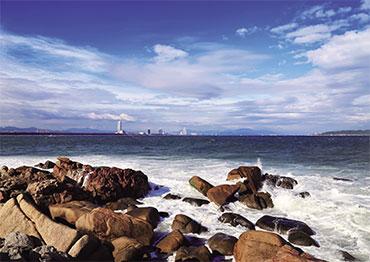fter the BBC did a video report about the new popularity of surfing in China, driven by the surge in domestic tourism due to the pandemic, I had a sort of mild Twitter spat with the correspondent, who seemed to mistake my lighthearted remarks about the standard I’d seen while down there as a criticism of the report.
I had to go to the tropical island of Hainan, dangling just below the Chinese mainland coast in the South China Sea, part of my quest to visit all the provinces and regions. I’m from a coastal town, and I do like the sea and the beach, but I’m not a beach holiday person, tiring very quickly of sunbathing. A friend, who is a sun worshipper, recommended the resort of Houhai, a surfing mecca she said, and very chilled out.
This appealed to me, although I’m not a surfer, as I didn’t fancy the sort of built-up resort strip that I imagined the popular places in Hainan to be, like Sanya or Yalong Bay. My images of that came from evil prehistoric shark movie, The Meg, where I was disappointed the huge shark failed to snack on the hordes of swimmers bobbing around in rubber rings in the water like a floating Las Vegas buffet.
I landed in Haikou, capital of the island, which I liked a lot, even though the heat in early June was such that I have never been so grateful to see that the overpasses had escalators. If Haikou ever gets cooler, I’d like to go back, especially as there are some exciting initiatives going on, like the just-opened Cloudscape Library along Haikou Bay, the first of 16 pavilions by prominent architects to regenerate the area.
But a quick journey to the high-speed railway station, and a fast train will whisk you to the southern resorts in about 90 minutes. The high-speed rail line encircles the island, so if you want, you can circumnavigate the whole place.
The hotel had arranged a pick-up at the station, so another 30 minutes and we arrived at Houhai, a small peninsula shaped like a dog bone, just a few 100 meters across at the narrowest point. I was warned it was largely pedestrianized, so an electric buggy with a driver, mouth stained red with betel juice, showed up to take me to the hotel, a relatively new place on the quieter side of the peninsula.
First impressions were not promising. I’d arrived around dinner time, and the main street, lined with restaurants on both sides, was packed, a bit like the sea in The Meg. I’ve been hoodwinked, I thought. It was the opposite of chilled, more like a busy shopping street on a national holiday. However, the hotel, Santing Flowers, which had kindly given me a free upgrade to the top floor, was right on the beach. Not long after arriving was one of the best sunsets I’d seen for a long time, the sky crimson red and pink and behind, the lights of the tall hotels and attractions of Haitang Bay to the north.

 Old Version
Old Version

